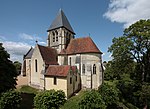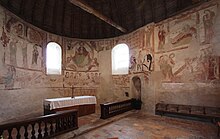Troo
| Troo | ||
|---|---|---|

|
|
|
| region | Center-Val de Loire | |
| Department | Loir-et-Cher | |
| Arrondissement | Vendôme | |
| Canton | Montoire-sur-le-Loir | |
| Community association | Territoires Vendômois | |
| Coordinates | 47 ° 47 ' N , 0 ° 48' E | |
| height | 58-154 m | |
| surface | 14.19 km 2 | |
| Residents | 297 (January 1, 2017) | |
| Population density | 21 inhabitants / km 2 | |
| Post Code | 41800 | |
| INSEE code | 41265 | |
Troo is a French municipality with 297 inhabitants (at January 1, 2017) in the department of Loir-et-Cher in the region Center-Val de Loire .
history
The settlement of the Loir Valley around Vendôme has been linked to the use of caves as living space for centuries. Troo has developed on this basis since the time of the Norman invasions in the 9th century. In the Middle Ages , the place was the seat of a seigneurie and was protected by a fortification. The city reached its greatest prosperity in the 11th and 12th centuries. At that time it had about 4500 inhabitants, most of whom lived in cave dwellings.
Around 1188 Troo was taken along with the neighboring Montoire by Henry II of England and his son Richard the Lionheart .
Attractions
Troo lies on a steeply sloping tufa elevation above the river. This place has been populated since ancient times.
Former collegiate church of Saint-Martin
There have been a significant number of churches in Troo over the centuries. All that remains is a Romanesque church, the former collegiate church of Saint-Martin, around which some old houses are grouped on the top level.
The church, begun in 1050, was redesigned in the 12th century. The window arches of the square tower have, as is usual in the Anjou style, a column decoration in the reveal . The Romanesque apse has Gothic windows.
“La Butte”, a hill next to the church, offers a wide view of the winding Loir.
Maladrerie Sainte-Catherine
The "Maladrerie" Sainte-Catherine also dates back to the 12th century, the remains of which include dazzling arcades that are worth seeing. This is where pilgrims who had fallen ill on the route to Santiago de Compostela found help . The name "Maladrerie" was taken over after the dissolution of an outlying leprosarium along with its goods.
Cave dwellings
The "inhabited caves" are spread over two levels over the slope. Some are still used today as private apartments, or they are used as storage rooms or for mushroom cultivation. You can visit the Cave Yuccas , which was inhabited until 1965 and is furnished like an apartment at the beginning of the 20th century.
Another facility is rented out to guests (gite rural).
Petrifiante grotto
Stalactite cave with remarkable stalactites through which water still flows.
Saint-Jacques-des-Guérets village church
Outwardly modest, the village church on the other side of the river has unusually well-preserved wall paintings on the inside. The single-nave hall structure, which dates from the 12th century, has a semicircular, slightly indented end of the choir. The paintings can be dated to around 1200 and show the transition from the Romanesque to the Gothic design tendencies. The semicircle of the choir and the south wall of the nave are painted with the following representations:
- On the left a crucifixion: Christ on the cross between Mary and John, above the allegories sun and moon in mourning gesture. - The raising of the dead under the crucifixion.
- To the right of the central choir window a Majestas Domini, surrounded by the evangelist symbols. - Including the last supper.
- Above the adjacent window on the right, two angels and on the right of the window in the upper row the heavenly Jerusalem: Peter opens paradise for two souls who join the resurrected. In the middle row the martyrdom of the church patron James the Elder. Ä .: on the right Herod in the characteristic pose of the (evil) ruler with crossed leg, on the left the collapsing apostle, in the middle the executioner turning to Herod. - The allegories of pride and despair above the window.
- On the south wall of the nave, faintly visible: St. Nikolaus presents the three sleeping daughters of a poor man who wanted to hand them over to prostitution with three golden balls; to the right of this scene a standing Maria with child as a counterpart to the figure of Santa Claus. - Under the picture of St. Nicholas the raising of Lazarus.
literature
- Castles on the Loire . The green travel guide. Michelin Reise-Verlag, Landau-Mörlheim 1997, ISBN 2-06-711591-X , p. 313.
- Wilfried Hansmann : The Loire Valley. Castles, churches and cities in the «Garden of France» . 2nd Edition. DuMont Reiseverlag, Ostfildern 2006, ISBN 3-7701-6614-0 , p. 246 .



